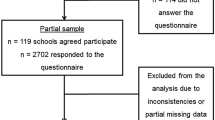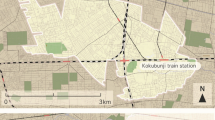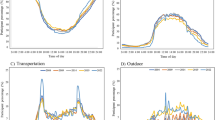Abstract
Background
The outdoor time is a key factor that determines children’s exposure to environmental contaminants. Meanwhile, children reap numerous physical and mental health benefits from playing outdoors.
Objective
This study aimed to characterize the distributions and identify determinants of the time spent outdoors among school-age children in China.
Methods
The study recruited 41,439 children aged 6–17 years in Mainland China using a multi-stage cluster random sampling method. This sample was nationally representative with sample weights created to account for the complex survey design. Information on time-activity patterns were collected with a standard questionnaire through face-to-face interviews. Frequency distributions of time outdoors were created by age group, gender, region, and other sociodemographic factors with sample weights. The key factors influencing time outdoors were identified using multivariable linear regression models.
Results
The grand mean (±standard deviation) time outdoors was 101 ± 51 min/day for all the study participants, 22.3% having <60 min/day. Children spent longer time outdoors in warm seasons and on weekends. Children’s outdoor time was significantly influenced by gender, age, urbanicity, region, annual total household expenditure, building environment, and meteorological conditions (annual mean temperature, sunshine time, and precipitation). Girls, 15–17 year old, and urban children had 6 min/day, 8 min/day, and 13 min/day less outdoor time than boys, 6–8 year old, and rural children, respectively. Most significantly, urban girls and high school students had the shortest outdoor time. The cement ground was the most important type of ground for children playing outside.
Significance
This was the first national-scale study that characterized the time outdoors and where is it spent among school-age children in China. It revealed that one-fifth of Chinese children spent less than one hour outdoors every day, and urban girls had particular “indoor tendencies”. The findings provide bases for future interventions and guidelines aimed at promoting children’s physical activities.
This is a preview of subscription content, access via your institution
Access options
Subscribe to this journal
Receive 6 print issues and online access
$259.00 per year
only $43.17 per issue
Buy this article
- Purchase on Springer Link
- Instant access to full article PDF
Prices may be subject to local taxes which are calculated during checkout



Similar content being viewed by others
References
Mccurdy T, Graham SE. Using human activity data in exposure models: analysis of discriminating factors. J Expo Anal Environ Epidemiol. 2003;13:294–317.
Decastro BR, Sax SN, Chillrud SN, Kinney PL, Spengler JD. Modeling time-location patterns of inner-city high school students in New York and Los Angeles using a longitudinal approach with generalized estimating equations. J Expo Sci Environ Epidemiol. 2007;17:233–47.
Robinson JP, Silvers A. Measuring potential exposure to environmental pollutants: time spent with soil and time spent outdoors. J Expo Sci Environ Epidemiol. 2000;10:341–54.
Lane KJ, Levy JI, Scammell MK, Patton AP, Durant JL, Mwamburi M, et al. Effect of time-activity adjustment on exposure assessment for traffic-related ultrafine particles. J Expo Sci Environ Epidemiol. 2015;25:506–16.
Corlin L, Ball S, Woodin M, Patton AP, Lane K, Durant JL, et al. Relationship of time-activity-adjusted particle number concentration with blood pressure. Int J Environ Res Public Health. 2018;15:2036.
Gray C, Gibbons R, Larouche R, Sandseter EBH, Bienenstock A, Brussoni M, et al. What is the relationship between outdoor time and physical activity, sedentary behaviour, and physical fitness in children? A systematic review. Int J Environ Res Public Health. 2015;12:6455–74.
Schaefer L, Plotnikoff RC, Majumdar SR, Mollard R, Woo M, Sadman R, et al. Outdoor time is associated with physical activity, sedentary time, and cardiorespiratory fitness in youth. J Pediatr. 2014;165:516–21.
Larouche R, Garriguet D, Tremblay MS. Outdoor time, physical activity and sedentary time among young children: The 2012-2013 Canadian Health Measures Survey. Can J Public Health. 2017;107:e500–6.
Janssen I, Leblanc AG. Systematic review of the health benefits of physical activity and fitness in school-aged children and youth. Int J Behav Nutr Phys Act. 2010;7:40.
Cleland V, Crawford D, Baur LA, Hume C, Timperio A, Salmon J. A prospective examination of children’s time spent outdoors, objectively measured physical activity and overweight. Int J Obes. 2008;32:1685–93.
Lichtveld K, Thomas K, Tulve NS. Chemical and non-chemical stressors affecting childhood obesity: a systematic scoping review. J Expo Sci Environ Epidemiol. 2018;28:1–12.
He MG, Xiang F, Zeng YF, Mai JC, Chen Q, Zhang J, et al. Effect of time spent outdoors at school on the development of myopia among children in China: a randomized clinical trial. JAMA. 2015;314:1142–8.
Guo Y, Liu LJ, Xu L, Lv YY, Tang P, Feng Y, et al. Outdoor activity and myopia among primary students in rural and urban regions of Beijing. Ophthalmology. 2013;120:277–83.
Rose KA, Morgan IG, IP J, Kifley A, Huynh S, Smith W, et al. Outdoor activity reduces the prevalence of myopia in children. Ophthalmology. 2008;115:1279–85.
Soyeon A, Fedewa AL. A meta-analysis of the relationship between children’s physical activity and mental health. J Pediatr Psychol. 2011;4:385–97.
Korpela K, Bloom JD, Sianoja M, Pasanen T, Kinnunen U. Nature at home and at work: naturally good? Links between window views, indoor plants, outdoor activities and employee well-being over one year. Landsc Urban Plan. 2017;160:38–47.
Dowdell K, Gray T, Malone K. Nature and its influence on children’s outdoor play. Aust J Outdoor Educ. 2011;15:24–35.
Ming K, Frances E. Nature-deficit disorder: evidence, dosage, and treatment. J Policy Res Tour Leis Events. 2012;5:172–86.
Bassett DR, John D, Conger SA, Fitzhugh EC, Coe DP. Trends in physical activity and sedentary behaviors of United States youth. J Phys Act Health. 2015;12:1102–11.
Pergams ORW, Zaradic PA. Evidence for a fundamental and pervasive shift away from nature-based recreation. Proc Natl Acad Sci USA. 2008;105:2295–300.
U.S. EPA. Exposure Factors Handbook 2011 Edition (Final Report). U.S. Environmental Protection Agency, Washington, DC, EPA/600/R-09/052F, 2011. https://cfpub.epa.gov/ncea/efp/recordisplay.cfm?deid=236252.
Conrad A, Seiwert M, Huenken A, Quarcoo D, Schlaud M, Groneberg D. The German environmental survey for children (GerES IV): reference values and distributions for time-location patterns of German children. Int J Hyg Environ Health. 2013;216:25–34.
Matz CJ, Stieb DM, Davis K, Egyed M, Rose A, Chou B. Effects of age, season, gender and urban-rural status on time-activity: Canadian Human activity pattern survey 2 (CHAPS 2). Int J Environ Res Public Health. 2014;11:2108–24.
Hofferth SL. Changes in American children’s time - 1997 to 2003. Electron Int J Time Use Res. 2009;6:26–47.
Lachowycz K, Jones AP, Page AS, Wheeler BW, Cooper AR. What can global positioning systems tell us about the contribution of different types of urban greenspace to children’s physical activity? Health Place. 2012;18:586–94.
Pate RR, Saunders RP, O’Neill JR, Dowda M. Overcoming barriers to physical activity: helping youth be more active. ACSM’s Health Fit J. 2011;15:7–12.
Skar M, Krogh E. Changes in children’s nature-based experiences near home: from spontaneous play to adult-controlled, planned and organised activities. Child Geogr. 2009;7:339–54.
Wilkie HJ, Standage M, Gillison FB, Cumming SP, Katzmarzyk PT. The home electronic media environment and parental safety concerns: relationships with outdoor time after school and over the weekend among 9-11 year old children. Bmc Public Health. 2018;18:456.
Wen LM, Kite J, Merom D, Rissel C. Time spent playing outdoors after school and its relationship with independent mobility: a cross-sectional survey of children aged 10–12 years in Sydney, Australia. Int J Behav Nutr Phys Act. 2009;6:15.
Larson LR, Green GT, Cordell HK. Children’s time outdoors: results and implications of the national kids survey. J Park Recreat Admi. 2011;29:1–20.
Zhao Y, Wang SX, Chen GC, Wang F, Aunan K, Hao J. Microenvironmental time-activity patterns in Chongqing, China. Front Environ Sci China. 2009;3:200–9.
Xu RB, Gao D, Wang ZH, Zou ZY, Hu PJ, Jun M, et al. Analysis of the current status of outdoor activity time of Chinese students in 2016. CJCHC MAR. 2018;26:254–7.
Hubal EAC, Sheldon LS, Burke JM, McCurdy TR, Berry MR, Rigas ML, et al. Children’s exposure assessment: a review of factors influencing Children’s exposure, and the data available to characterize and assess that exposure. Environ Health Perspect. 2000;108:475–86.
Gent JF, Triche EW, Holford TR, Belanger K, Bracken MB, Beckett WS, et al. Association of low-level ozone and fine particles with respiratory symptoms in children with asthma. JAMA. 2003;290:1859–67.
Li ZY, Ma ZW, van der Kuijp TJ, Yuan ZW, Huang L. A review of soil heavy metal pollution from mines in China: pollution and health risk assessment. Sci Total Environ. 2014;468:843–53.
Suminski RR, Poston WC, Market P, Hyder M, Sara PA. Meteorological conditions are associated with physical activities performed in open-air settings. Int J Biometeorol. 2008;52:189–97.
Veitch J, Bagley S, Ball K, Salmon J. Where do children usually play? A qualitative study of parents’ perceptions of influences on children’s active free-play. Health Place. 2006;12:383–93.
National Bureau of Statistics of China. Division codes for statistics and urban-rural division codes, 2013. www.stats.gov.cn/tjsj/tjbz/tjyqhdmhcxhfdm/.
Zhao XG, Duan XL, Wang BB. Environmental exposure related activity patterns survey of Chinese population (children). China Environmental Science Press, Beijing, China; 2016.
Liang WG, Shen GF, Wang BB, Cao SZ, Yu DM, Zhao LY, et al. Space heating approaches in Chinese schools: results from the first Chinese environmental exposure-related human activity patterns survey-children (CEERHAPS-C). Energy Sustain Dev. 2020;56:33–41.
Zhuang ZJ, Wu JG, Lu GL, Niu CJ, Tang CX. Survey on daily activities of elementary and middle school students in Changning District. Shanghai Shanghai J Preventive Medcine. 2010;22:32–4.
Kim S, cheong HK, Choi K, Yang JY, Kim SJ, Jo SN, et al. Development of Korean exposure factors handbook for exposure for exposure assessment. Epidemiology. 2006;17:S460.
Mcfarland AL, Zajicek JM, Wallczek TM. The relationship between parental attitudes toward nature and the amount of time children spend in outdoor recreation. J Leis Res. 2014;46:525–39.
World Health Organization. Global recommendations on physical activity for health. World Health Organization, 2010. https://www.who.int/dietphysicalactivity/factsheet_recommendations/en/. Accessed 1 Jan 2010.
Chinese Children and Adolescents Physical Activity Guide Production Working Group. Physical activity guidelines for Chinese children and adolescents. Chin J Evid Based Pediatr. 2017;12:401–9.
Sherwin JC, Reacher MH, Keogh RH, Khawaja AP, Mackey DA, Foster PJ, et al. The Association between time spent outdoors and myopia in children and adolescents a systematic review and meta-analysis. Ophthalmology. 2012;119:2141–51.
Hu YC, Chen J, Wang R, Li M, Yun CF, Li WD, et al. Vitamin D nutritional status and its related factors for Chinese children and adolescents in 2010-2012. Nutrients. 2017;15:1024. 9
Madina S, Torben J, Rikke KJ, Allan L, Mette A. The influence of housing characteristics on leisure-time sitting. A prospective cohort study in Danish adults. Prev Med. 2015;81:58–62.
Wu XY, Gao GP, Jin JX, Hua WJ, Tao LM, Xu SJ. et al. Housing type and myopia: the mediating role of parental myopia. BMC Ophthalmol. 2016;31:151.
Houshmand EM. Associations of built environment and children’s physical activity: a narrative review. Rev Environ Health. 2017;32:315–31.
Lee S, Lee K. Seasonal differences in determinants of time location patterns in an urban population: a large population-based study in Korea. Int J Environ Res Public Health. 2017;14:672.
Deffner V, Kuechenhoff H, Maier V, Pitz M, Cyrys J, Breitner S, et al. Personal exposure to ultrafine particles: two-level statistical modeling of background exposure and time-activity patterns during three seasons. J Expo Sci Environ Epidemiol. 2016;26:17–25.
Paustenbach DJ. The practice of exposure assessment: a state-of-the-art review. J Toxicol Environ Health B Crit Rev. 2000;3:179–291.
Ministry of Education of the People’s republic of China. 2014 national education development statistical communique. Ministry of Education of the People’s republic of China 2015. http://www.moe.gov.cn/srcsite/A03/s180/moe_633/201508/t20150811_199589.html. Accessed 30 July 2015.
Hume C, Salmon J, Ball K. Children’s perceptions of their home and neighborhood environments, and their association with objectively measured physical activity: a qualitative and quantitative study. Health Educ Res. 2005;20:1–13.
Acknowledgements
We thank all the participating children and parents for their valuable time, the participating schools for their cooperation, and the field surveyors for their field data collection.
Funding
This work was supported by the National Science Foundation of China, Grant/Award [41977374] and the Ministry of Ecology and Environment of China [EH 2013-09-01].
Author information
Authors and Affiliations
Contributions
FG was responsible for methodology, analysing data, and writing original draft, visualization, review & editing. QG was responsible for methodology, analysing data and data visualization. BW conducted investigation, survey design, data collection, review & editing. SC conducted investigation, survey design, data collection and curation. NQ was responsible for interpreting results, updating reference lists. LZ conducted investigation, data collection and curation. CJ was responsible for methodology, revised the manuscript, language editing, review & editing. XD conceptualization, methodology, investigation, data curation, writing—review & editing, supervision, project administration, funding acquisition.
Corresponding authors
Ethics declarations
Competing interests
The authors declare no competing interests.
Additional information
Publisher’s note Springer Nature remains neutral with regard to jurisdictional claims in published maps and institutional affiliations.
Rights and permissions
About this article
Cite this article
Gao, F., Guo, Q., Wang, B. et al. Distributions and determinants of time spent outdoors among school-age children in China. J Expo Sci Environ Epidemiol 32, 223–231 (2022). https://doi.org/10.1038/s41370-021-00401-w
Received:
Revised:
Accepted:
Published:
Issue Date:
DOI: https://doi.org/10.1038/s41370-021-00401-w



